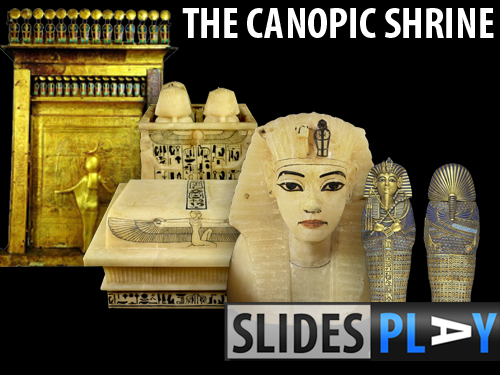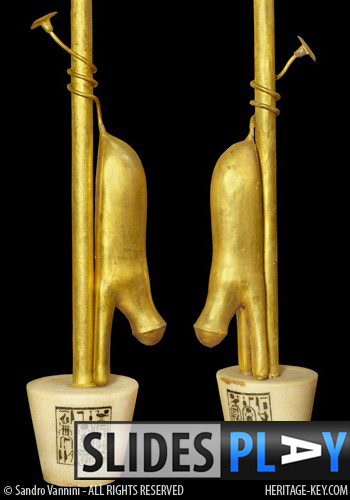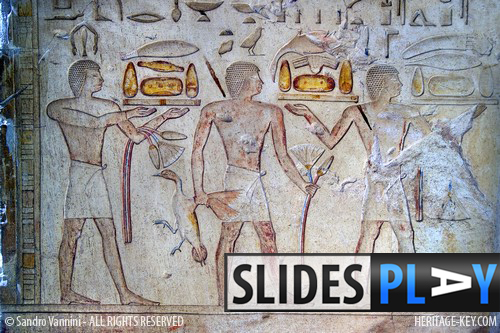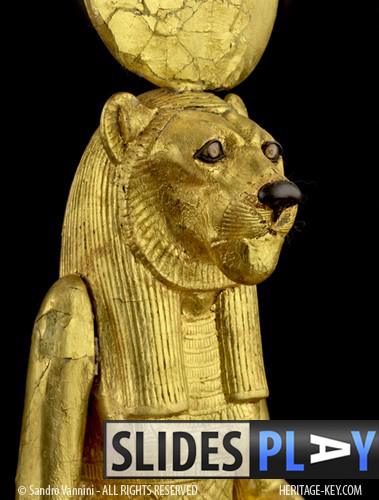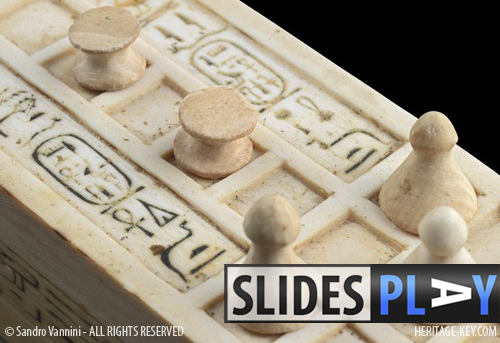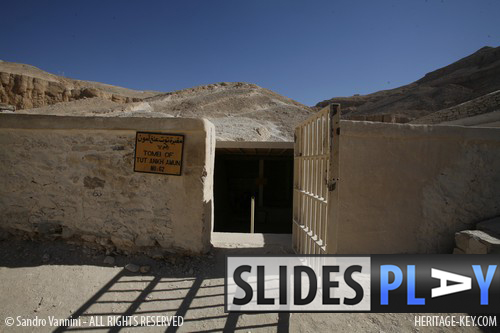Several alabaster artefacts were discovered inside the Tomb of King Tutankhamun (KV62) by Howard Carter when he began excavating the tomb in 1922. The Canopic Shrine was one of the intruiging discoveries for how packed together it was, with a box containing several artefacts in a manner comparable to a Russian doll! The Canopic Shrine is a large gilded wooden box flanked by a Canopy and supported on a sledge. Inside the shrine was the Canopic Chest, which has four hollowed spaces inside which are sealed by Human-Headed Stoppers. Inside the hollows were four small Canopic Coffinettes. ‘Canopic Shrine’ Slideshow…
-
-
Anubis is the jackal-headed god for the afterlife and mummification, who is seen as a key figure for a Pharaoh to pass into the afterlife. The jackal was associated with associated with death and burials in Ancient Egyptian time for their reputation of scavenging human corpses and eating their flesh. It was common practice to place a figure of Anubis near the entrance of a tomb, and for the priest to don an Anubis mask during the embalming process. This is also one of the reasons the Anubis was selected to sail into New York’s harbour to promote the upcoming…
-
The original excavation of TT34 – The Tomb of Montuemhat – was carried out by archaeologist Zakaria Gomein, upon the pressure unfortunately got the better of him and resulted in suidcide in a fascinating tale recounted by Dr Zahi Hawass (Watch the video).The project lead is now Dr Farouk Gomaa who is searching TT34 for the burial chamber of the diplomat Montuemhat, and explains his progress in a Heritage Key video (Watch the video). Egyptology photographer has been busy across Thebes, and TT34 has been just one of many of the tombs in the area where he has taken his…
-
Housed inside Cairo’s Egyptian Museum are many of the artefacts from King Tutankhamun’s tomb (KV62) including the Ritual Figure of Sekhmet, which was discovered in 1922 by the great explorer Howard Carter and his financier Lord Carnarvon. The two men who had a trusting and close bond, as well as a love for Egyptology as explained by his modern day ancestors in a Heritage Key interview (Watch the video about Carter and Carnarvon). Included in the discovery were 34 ritual figures, believed to be of significant importance in the burial ceremony. Egyptology photographer Sandro Vannini has been capturing many of…
-
Egyptology photographer Sandro Vannini has been busy photographing tombs across Thebes for his new book “The Lost Tombs of Thebes:Lost in Paradise” and you can watch him at work in a Heritage Key video which also features Dr Zahi Hawass and Dr Janice Kamrin (Watch the video). During his photo-spree in this Ancient Egyptian city, Sandro took images of archaeologists hard at work at the site of TT34 – The Tomb of Montuemhat. Described by the excavation lead Dr Farouk Gomaa as “one of the largest [tombs] in Thebes“, the University of Tbingen archaeologist and his team are searching for…
-
Four Senet boards were found inside the tomb of King Tutankhamun and suggests that the boy king was a keen player of the ancient game. In Ancient Egyptian society, senet was regarded as much more than just a game, however – it was a matter of life or death. The game involves throwing casting sticks or knucklebones, and over time became regarded as talismans for the journey into the afterlife with luck being a key deciding factor in the game. Those who would win games of senet were believed to be blessed by powerful gods such as Osiris, Ra and…
-
When the entrance to the Tomb of King Tutankhamun (KV62) was discovered by the great explorer Howard Carter and his financier Lord Carnarvon, they could never have dreamed of the treasures which awaited them inside. These two men worked together to track down King Tut’s burial place, as explained in a Heritage Key video with Lord Carnarvon’s modern day ancestors the Earl and Countess of Carnarvon (Watch the Video). Egyptology photographer Sandro Vannini has spent much of the past decade photographing the fascinating artefacts discovered inside KV62, as well as capturing the tomb itself on film. But an angle that…
-
Discovered inside the Tomb of King Tutankhamun, inside black resin-covered wooden shrines which were accessible via double doors, were 34 ritual figures. Of significant importance during the ritual ceremony, these statuettes are believed to assist the King Tut’s passage to the afterlife. Upon discovering the shrines in KV62, the great explorer Howard Carter found only one of the boxes had been raided by tomb robbers, with the rest laying undisturbed since antiquity. The ritual figures are now housed inside Cairo’s Egyptian Museum and have been captured on film by Sandro Vannini, who has photographed Egypt’s greatest treasures including the famous…
-
Bergama, Turkey is a city in the west of the country, located near the Bakray river and is home to the ruins of the Roman city of Pergamon (or Pergamum), which lie to the north and west of the modern day site. The ancient city is believed to have had a population of around 150,000 people at its peak in the First Century AD. Thanks to GeoEye who have provided a high resolution satellite image of the region, we can see the relationship between the modern city and its ancient past. Of all the amazing sites in the area surrounding…
-
Many archaeological excavations are taking place across Egypt as the wonders of the Ancient World continue to reveal themselves to us. One such excavation taking place is at el-Assasif, Thebes at the site of TT34 – the Tomb of Montuemhat. The archaeological dig, led by Dr Farouk Gomaa, is searching for the yet undiscovered burial chamber of the diplomat Montuemhat. Renown photographer Sandro Vannini captured images of the excavations in progress at TT34, as well as covering many spectacular images in his publication “The Lost Tombs of Thebes: Life in Paradise” authored by Dr Zahi Hawass (Watch a video about…

